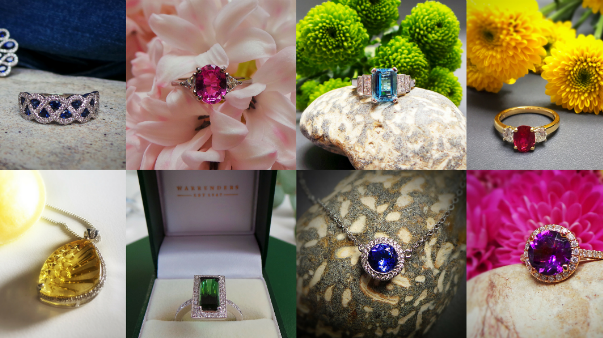A guide to coloured gemstones

There are many different types of precious gemstone each with specific properties including various hardness and different depth of colour. At Warrenders we use products of nature that fall into the following categories:
Minerals - formed in the earth in the form of rocks and crystals
Gems – organic origin such as pearls and opals
Read on for our breakdown of the most popular coloured stones.
Top of the list is the regal sapphire. Famously used in Princess Diana’s engagement ring which now sits on the finger of the Duchess of Cambridge, sapphires are believed to symbolise wisdom, virtue and good fortune.
Part of the Corundum family, sapphires are second in hardness only to diamonds which makes them an excellent choice for frequently worn pieces such as engagement rings. Sapphires are most often thought of as blue in colour and they do come in some beautiful blues ranging from delicate baby blue to darkest navy, with cornflower being the most sought after. However, sapphires also come in pronounced shades of yellow, green, pink, purple and orange. The best sapphires generally hail from Sri Lanka, where many of the cornflower coloured specimens come from, but excellent stones are also found in Kashmir and the USA while many of the other colour shades come from Madagascar.
Also from the Corundum family and famed as one of the hardest minerals on earth, the blushing ruby is a beautiful addition to any jewellery box. This exquisite stone comes in a range of colours from pale rose-red to deep carmine, with the finest jewels having a pure, vibrant red colour. They are believed to represent love and power and have held an important place amongst many cultures throughout history.
Unlike other gemstones, inclusions do not tend to affect the quality of a ruby, unless they change the transparency of the stone or are located right at the centre of its table. Rubies are mainly sourced from Burma, Thailand and Sri Lanka. They are found in very few places due to the essential compound chromic oxide being a scarce substance, which makes the best rubies very rare.
Favoured by Cleopatra who was said to have a huge collection of emeralds, this dazzling stone is part of the Beryl family and comes in a wide spectrum of different greens. Emeralds are prone to inclusions and therefore an unflawed emerald is very rare and one of the most expensive gemstones on earth. Emeralds are believed to represent healing and fertility, the vibrant green of the stone also suggests the concept of eternity, growth and renewal.
Interestingly the colour of an emerald varies depending on where it was formed, so you should be able to tell its origin just by looking at it. The most desired emeralds are bluish green to pure green and have vivid colour saturation. As early as 2000 BC emeralds were mined in the Cleopatra Emerald Mines near the Red Sea in Egypt. However, today the main sources of fine emeralds are Brazil and the Colombian Andes.
Evoking the cool blue of seawater, the beautiful aquamarine is part of the Beryl family. Ranging in colour from almost colourless blue to a vibrant azure blue, this popular stone is almost always free from inclusions, has excellent hardness and breath-taking brilliance.
Symbolising happiness and everlasting youth, in the past the most valuable stones were green in colour, today however intense, bright blue stones fetch the highest price.
The majority of aquamarine gemstones are sourced from Brazil, however they are also found in Nigeria, Madagascar, Mozambique, Afghanistan and Pakistan.
The opulent opal traditionally hails from Australia and can come in a range of colours including black, white, blue, green, red, pink and grey.
Opals are often characterised by the flashes of coloured light which appear to radiate from within, however not all opals possess this quality. The iridescent colours of precious opals are caused by the minute spheres of amorphous silica that make up the stone, these interfere with the reflection and refraction of light creating a play of colour within.
The most valuable opals tend to be black or dark bodied stones as they often display the colours more vibrantly.
Favoured by royals the world over, the vibrant amethyst ranges in colour from delicate lilac to deepest purple. The Victorians were fond of the paler shades which were sometimes called the Rose De France. However, the richer shades are often the most valuable – especially a rich purple with rose flashes.
Amethyst is typically found in Brazil, Uruguay, Bolivia and Argentina as well as some African countries.
Beautiful and traditional, pearls have been treasured by many for thousands of years. Even the Romans valued pearls so highly that they passed a law permitting only people of very high rank to wear them.
Pearls are divided into two main groups, freshwater and seawater. Freshwater pearls are generally made by Mussels who are able to create several pearls at a time, whereas seawater pearls come from Oysters which only produce one pearl.
Typically, an Oyster pearl is shapelier with a superior lustre which can mean that these are more coveted than their freshwater counterparts. Lustre, colour, shape, size and clarity all determine the quality and value of a pearl. Cultured pearls can also have different ground colours including; white, silver, pink, yellow, green, gold and bronze. They also come in fancy colours, the most common being blue or black.
Larger pearls of 9mm and above tend to come from warmer climates and are known as South Sea Pearls. Pearls are commonly sourced from Japan, China, the Persian Gulf, Sri Lanka and the North-West coast of Australia.
